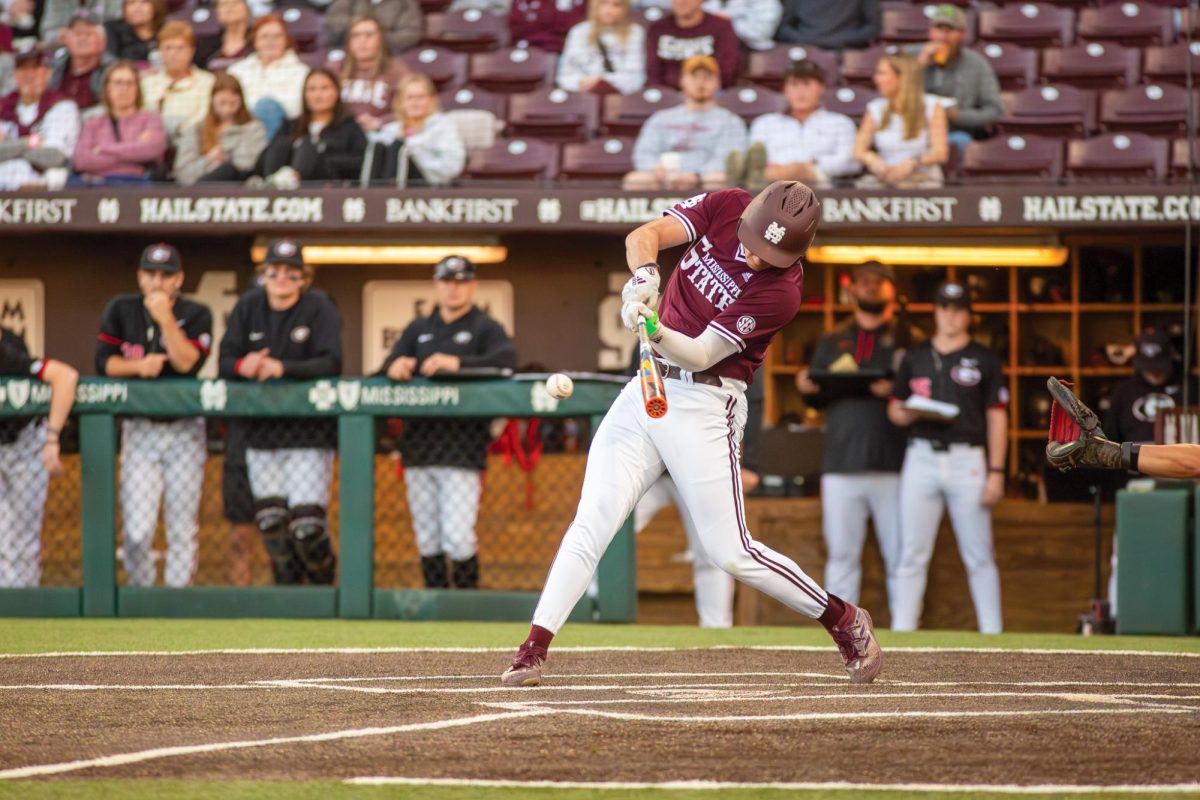Quarterbacks feared them. Running backs hated them. And wide receivers cringed at the thought of running a crossing route against them.
They were beasts; tenacious, stingy, hard-nosed beasts, who drooled at the thought of laying out an opposing player and then spitting in his face for spite.
They were reckless animals that laid their bodies on the line every Saturday. Their fierce licks could be heard from the upper decks of the highest stadiums.
The 1999-2000 Mississippi State defense will live forever in the minds of the maroon faithful. That defense led a sluggish offense to a 10-2 overall record and a 6-2 mark in the SEC. They were ranked No. 1 in the nation in total defense, giving up only 222 yards per game. They held 11 of 12 opponents under 21 points that year and only allowed 66 rushing yards per game, which ranked them No. 1 nationally.
But things began to slide. Year after year the defense slipped further and further away from its once great legacy.
The 2000 defense ranked 36th nationally and 53rd in points allowed per game, after being ranked sixth in that category a year before.
The following year, the first of a three-year losing skid, they dropped further in the defensive rankings, finishing 59th nationally in total defense. They also gave up 60 more rushing yards than they had the year before.
The 2002 defense, the last year defensive coordinator Joe Lee Dunn held the reigns, ranked 82nd in rushing defense and 77th in points allowed a game, allowing over 28 points per outing. A new staff took charge in 2003, and instead of bettering the program, they took it to new lows. The defense finished 113th in total defense at the end of a 2-10 season, allowing over 472 yards per game. They gave up 39 points per game, ranking them dead last in the nation.
Another new staff has taken the reigns. In their first year, they have indeed bettered a once floundering defense.
The Bulldogs ranked 51st in total defense and 11th in pass defense.
They concluded the season with great promise for the coming years by only allowing the final four opponents an average of 20 points per game, which includes holding Kentucky to a touchdown and scoring nine defensive points on the Wildcats.
But defensive coordinator Ellis Johnson is looking to improve on the improvements he’s already made to his defense.
Johnson and his staff revamped their original defensive scheme during the Bulldogs’ bye week last year-between the UAB game and the Florida game. Johnson says they will keep with this new scheme, which calls for a quicker, smaller set of linebackers, only two defensive tackles and two agile defensive ends.
“We went more to a true 4-3 (four down linemen and three linebackers) package with three linebackers playing off the line of scrimmage and two true defensive ends instead of a 50 (five down linemen and two linebackers) look that we were mixing around,” Johnson said.
“We feel like, right now, we are playing the best X’s and O’s we can play to get the best players on the field.”
There were a couple of primary reasons why Johnson switched to this new defensive system. The first being to simplify the defense for the sake of the young linebackers that stepped into the starting lineup before the Florida game.
“We had to (change the defense) because that was when we pushed those young linebackers into the starting lineup and moved Quinton (Culberson) from safety to linebacker,” Johnson said. “From that point on we were very simple and changed our philosophy. We continued that progression into the spring with our system.”
The second reason he switched schemes was for recruiting purposes and because of the present talent that he has to work with.
“We can now recruit the smaller, faster linebackers,” Johnson said. “We’d still love to have the 6-foot-1, or better, 225-pound or better, linebackers, but we can play with a smaller guy now if he’s fast enough. Year in and year out here we can recruit those kind of players, and we had some of them here.”
Johnson said the same goes with the defensive ends.
“We’re playing with smaller, rangier defensive ends. When I say smaller, I’m talking hopefully the 6-foot-3, or better, 250 pounds or bigger. We still like to have that kind of size at the defensive end position, but rather than playing what was really a three defensive line system that we had, we’ve going more to two.”
That was objective No. 2 of spring practice – to develop the new defensive scheme throughout the spring. Objective No. 1 was to rearrange the defense, as far as personnel is concerned.
There were four personnel moves on the defense: Deljuan Robinson, 6-foot-4, 295 pounds, moved from defensive end to defensive tackle. Sophomore Titus Brown, 6-foot-3, 234 pounds, moved from linebacker to defensive end. Quinton Culberson, 6-foot, 228 pounds, moved from outside to inside linebacker. And Mario Bobo, 6-foot-1, 170 pounds, moved from cornerback to safety.
“Those were all very positive moves,” Johnson said. “We also had some guys really improve. The most improved player was Avery Hannibal, which was tremendous for us because we are really concerned about our depth inside at tackle.”
Hannibal, 6-foot, 254 pounds, is listed as the second string defensive tackle behind Deljuan Robinson.
After a grueling month of spring practice, the defense is better all around, Johnson said.
“We’re as good or better at every individual position on our defense. As a total unit, there’s no question in mind we are a little bit quicker,” Johnson remarked. “I think we are probably a lot more disciplined. All the intangibles are coming together and that’s a lot because of what coach [Croom] has done.”
Johnson sets what he calls benchmarks for his team during the season. Each week he picks out the third best team in the Southeastern Conference in each defensive category. He doesn’t care who the team is; he cares about only the statistical number. Whatever the third best number is, is what he wants his defense to surpass.
For example, if the third place team in rushing yards allowed gives up 120 rushing yards per game, then Johnson wants his team to give up no more than 120 rushing yards to its opponent in that particular weekend’s game.
Along with benchmarks, the defense has four basic goals.
“I’m not real big on goals, especially in a situation where you’re coming into a program that’s got to be totally rebuilt,” Johnson said. “No. 1 is to win. No. 2 is try not to give up more than two touchdowns a game. No. 3 do not give up a rushing touchdown on goal line defense.”
Johnson added, “No. 4, we want to be successful at least 35 percent of the time in the red zone at not giving up any points. That means one-third of the time when people come into our red zone we want them to come up empty.”
Johnson was on the opposite side of the field, clad in Crimson and White, when he was at Alabama from 1990-93 and 1997-99, going up against State eight times. He describes his first day on the job as a Bulldog.
“My record against Mississippi State was 5-3 in those eight years I was at Alabama. So my impression of Mississippi State when I walked in the door was that this was a physical, tough, hard-nosed bunch of players,” Johnson said.
Johnson soon found out that instead of being a group of tough, hard-nosed players, the Bulldogs were undisciplined and slow.
“I didn’t see a lack of talent or physicalness size,” Johnson said. “I saw immediately that our team speed overall to me was not very impressive. And that’s coming from a 1-AA school (The Citadel, where Johnson was head coach) back to the SEC. You want to see a total difference. Because when I left Alabama [in 2000] and went to the Citadel, I could tell that there was a tremendous difference. The second thing was, the longer I was around them, I noticed they had no attention to detail on anything.”
Johnson gave a couple of examples of the undisciplined actions that the team illustrated in the first spring session, which caused Jackie Sherrill’s final squad to rank 116th out of 117 teams in turnover margin (40 total turnovers) and caused the same squad to rank 11th in the SEC in penalty yardage (72 yards in penalties a game).
“If it was to put your hand on the line, their hand is going to be three inches in front or four inches behind. It was just never behind the line. If it was on the whistle, they might go on the whistle or they might go whenever,” he said. “They were totally incapable of doing something in detail.”
Detail, the little things. That is what Ellis Johnson and his staff are trying to incorporate into the Mississippi State defense to return the Maroon and White to its former glory.
“We’re a long way to being a group that just totally knows that they’re going to be successful and has that cockiness and that confidence about them,” the 53-year-old said. “Some of them have got that attitude, and their competitive, but until the group gets across that hump you don’t truly have that. But they do have the work habits and the attitude about wanting to be good.”
Johnson said this group is much better in taking those small steps to becoming a winning team.
“They’re taking the little things more seriously. They pay attention better in meetings. They’re more attentive and focused in walk-throughs.”
Categories:
Ellis Johnson: Resurrecting defense of old
Ross Dellenger
•
August 24, 2005
0
Donate to The Reflector
Your donation will support the student journalists of Mississippi State University. Your contribution will allow us to purchase equipment and cover our annual website hosting costs.




